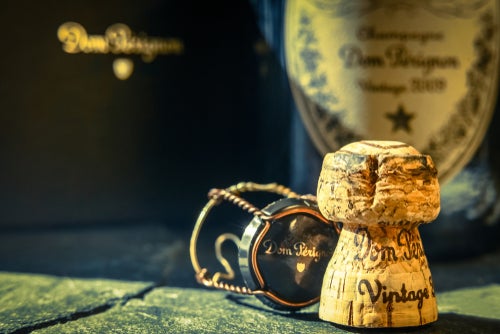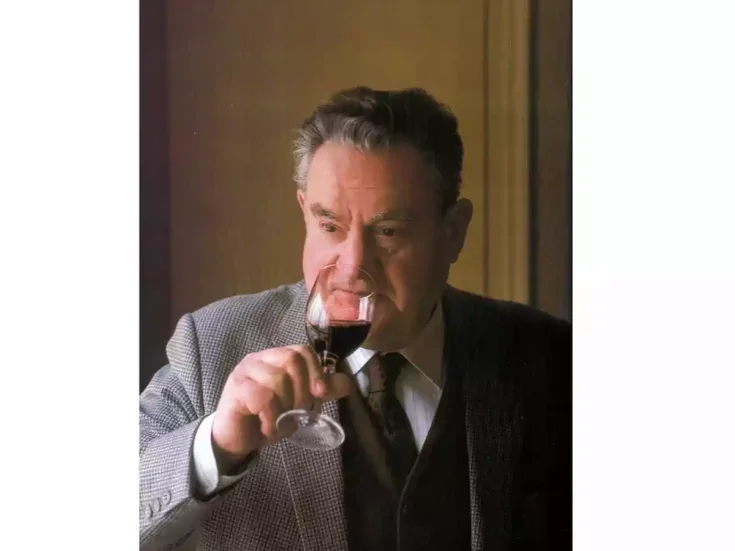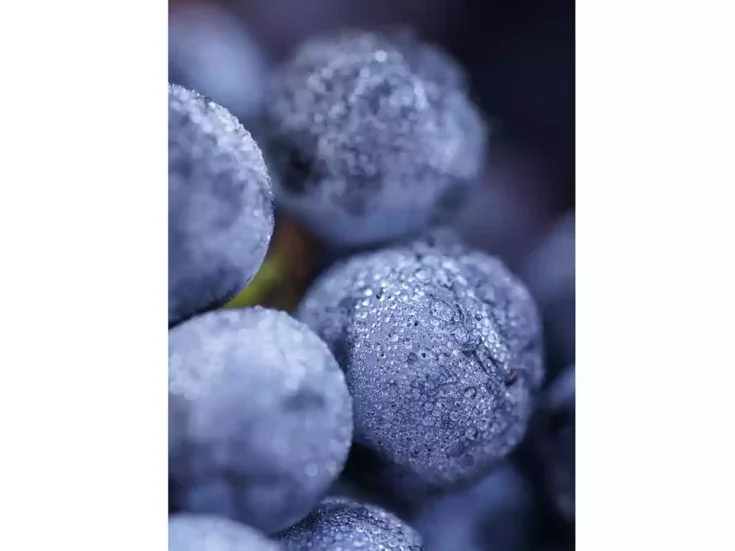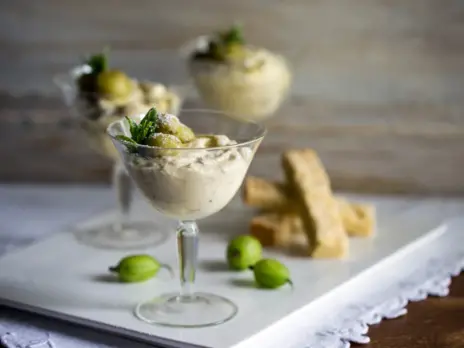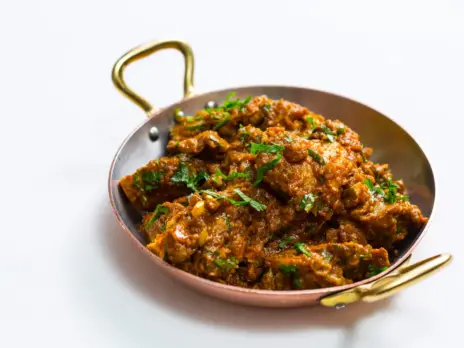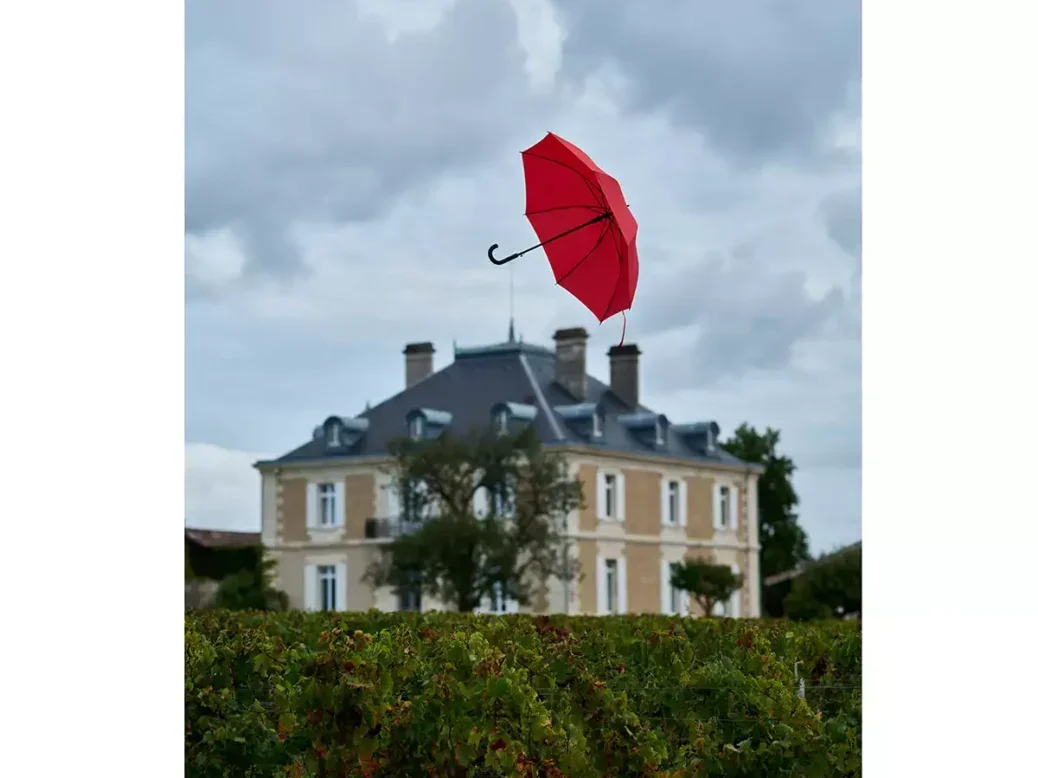
Simon Field MW assesses what the 2024 Bordeaux en primeur campaign means for the future of the region’s business model.
Singing in the Rain is the title of Haut-Bailly’s 2024 Bordeaux en primeur catalogue, with self-evident intimations of Gene Kelly optimism in the face of adversity, silk purses, sows’ ears, and the like. The booklet is punctuated, in the manner of Spielberg or Powell and Pressburger, by images of red umbrellas, symbols of stoicism, resilience and, ultimately, a positive outlook. Véronique Sanders, Haut-Bailly’s president, describes the vintage as “ultra-oceanic,” blighted by rain at precisely the wrong moments, and parsimonious in yield and intensity alike. A tricky vintage, in other words, at a tricky time. How did the season roll out and how is the market responding? How, most specifically, does the current en primeur model fall in with what is increasingly a buyer’s market, overstocked at source (and destination!) and with price stability fragile at best? Will all the talk of schadenfreude and hubris finally despoil a business model that was once lauded for, among other things, its magnificent self-importance and infectious chutzpah?
Bordeaux, built on mercantile wealth over three centuries, is no stranger to crisis. Crisis has been threaded through the fabric of its expensive cloth; and it should be so. The key to the style, quality, and longevity of the wines resides in the tension offered by their situation, itself mirrored structurally by a taut interface between tannin, fruit, and acidity in the claret itself. The maritime influence is as unpredictable as it is essential, both the lifeblood and (sometimes it seems) the death knell, and thus responsible for a stylistic imprimatur that is minutely localized. Terroir, they call it, I recall…. The wines should never be mistaken for examples from Stellenbosch, say, or Sonoma. If that happens, then one of the three key components mentioned above is out of kilter or has been doctored to such an extent that it has refined the product out of existence. The revenge of the Atlantic.
This illuminates another paradox: the paradox of plenty. Such has been the financial stability of the Bordelais that they have been able increasingly to “resort” to technological advances in support of their product in tricky years such as this. This can be dangerous, however, as it not only threatens to shroud the product in anonymity, but also escalates expense to such a degree that it may jeopardize the entire business model, especially at a time of uncertain interest rates. If yields are halved and variable costs are doubled, with fixed costs stubbornly and self-evidently fixed, the margin can be threatened irrevocably. Haut-Bailly and HB II are extremely well made, the former pleasingly fruity, the latter structured and refined, but neither bears the terroir-strewn hallmarks of absolutely top-class Pessac-Léognan. One does not doubt for a moment the technical expertise in play, some of it remedial, but one is entitled to question where such wines fit into the canon, and the extent to which the well-stocked collector or well-traveled investor will once again be tempted by their undoubted charms. Haut-Bailly, in recognition of the fragility of the market, has reduced its price by an unprecedented 36%. Laudable, for sure, but what signals does it send?
A buyer’s market, then, and one that is particularly vulnerable when it comes to an artifact such as en primeur. The first growths, prompted by Lafite and Mouton, have recognized the dilemma and have, just as in 2008, responded accordingly, launching their wine at the lowest prices since 2014 and thereby making them the cheapest buy on the market, by some distance in the case of Mouton. This putative stipulation, fed back from the marketplace, has now taken on the significance of an unspoken requirement, and any properties daring to defy its somewhat draconian implication—Pontet-Canet being an early example—may well pay the price with market indifference. The market is being driven down inexorably, therefore, to such an extent that a Darwinian race to the bottom will soon “find out” anyone over-geared or struggling under the weight of all the loan capital that has been necessary to maintain and upkeep the Doric pillars of the rather grand châteaux, complete with manicured gardens. The geopolitical backdrop is hardly helpful, with China apparently uninterested (those who bought property in the region are starting to divest), the USA market affected by uncertainty as to what the import tariffs are likely to be on eventual shipment, and the mature European markets weighed down by previous indulgence and an on-going love affair with Burgundy (which, thus far, seems to sing in less of a minor key). Everything, in short—and not least the quality of the vintage itself, Bordeaux’s leanest silhouette for some time—has conspired to spread uncertainly and doubt. And one does not have to be Ignatius Loyola, or even Schopenhauer, to recall that doubt saps energy and compromises the will to be active. Without transactional activity, there is nothing. Especially in Wonderland, where the product being sold does not exist at the time of sale.
The seasons
Véronique and her team certainly needed their red umbrellas in the growing cycle of 2024, the wettest for 25 years; some say even longer. The winter was exceptionally damp, pushing up the water table, but at the same time mild, fostering conditions that engendered unprecedented levels of mildew, itself appearing, almost inconceivable, before budbreak in early April. Thereafter rises in temperature and rainy conditions proved to be a dangerous combination, the more so when temperatures then dipped toward the end of the month. Mildew pressure was ubiquitous, therefore, from the third week in April, which also saw localized frost and intermittent hailstorms. The Bordeaux (contact) mixture was applied, then washed off by the rain, then re-applied, and so on. A somewhat old-fashioned cycle of effort and more effort, the dogged refusal to use “intravenous” herbicides to avoid the run-off problem rejected as a sop to the environment. Several properties, however, including illustrious names such as Domaine de Chevalier, decided to forsake organic principle for the year, such was the onslaught of the mildew. Properties in the process of conversion are hoping to have a retrospective dispensation, so that they can renew their pursuit in what everybody hopes will be a more benevolent 2025 season. It serves, nonetheless, to underline the significance of the episode. “Costly and labor-intensive… but necessary,” is how Jean-Dominique Videau at Branaire-Ducru describes the seemingly endless interventions. Cos d’Estournal was not unusual in spraying 26 times.
The mildew pressure continued through a wet May, with access to the vineyards often hampered and saturated roots ubiquitous, a clear advantage for well-draining gravel soils in favor of clay-based terrain. Aspect, topography, wind shelter, proximity to the river, and management of cover crops are several of the factors that took on a specific significance when it came to dealing with the syncopation of water. The cumulative rainfall from October 2023 to May 2024 was 43.1 inches (1,095mm), significantly higher than the average of 29.5 inches (750mm), and exceeded only in the far from auspicious vintages of 2008 and 1979. The sun didn’t come out that often and the natural light was not very bright. Gloom pervaded.
Flowering took place on average a week later than in 2023 but was itself intermittent and protracted. This resulted in poor fruit set (coulure) and patchy fertilization (millerandage) both with knock-on effects on ripening and, ultimately, yield. The somewhat unhelpful phenomenon of “in-bunch variation” was very commonplace, with rotten, unripe, and ripe grapes juxtaposed and constant vigilance required by the pickers. Sort, sort, and sort again become the mantra, and here, once more, crude economics come into play, with only a happy few able to bear the extra expense required to do the job “properly.” Fewer still could afford machinery that adds precision to the efforts of the human eye, and that, de facto, serves to reduce yet further an already parsimonious yield quota. The densimetric sorting machine, for example, eliminates berries that do not reach the required ripeness levels (reflected in the density). Thereafter the optic sorter sifts by size and, finally, there is more traditional hand-sorting, which picks out the rest of the detritus. Three lines of defense, three extra expenses, all, paradoxically, serving to reduce yield; the road to perdition as well as higher quality. Château Ducru-Beaucaillou sorted by all three methods and even then had to employ a saignée to concentrate the must in the winery. Not the easiest of times.
The inevitable warmer weather eventually materialized. After a dull June, July and August fared better, with rainfall 50% below the 30-year average and even some appearances from the sun. The talk of salvation was somewhat muted, however, with the rains returning to book-end September, thus making the harvest schedule extremely difficult both to predict and to negotiate. Veraison was extended, stretching from the end of July to the middle of August, with many growers choosing to de-leaf in order to give their vines a fighting chance of photosynthesis with some degree of regularity. By the middle of August, the well-drained soils were showing signs of hydric stress, itself welcome in moderation, thereby signaling that the vintage, in theory, was to be better than 2013 at least. Scant consolation, maybe.
The consolation and intimations of redemption were both challenged by the pattern of the September rains. There were 13 days of rain in September, 3.7 days more than the norm, most of which fell between the beginning of the month and the tenth, and then after the 21st. This left a narrow window for harvesting, with both early ripening Melot and later ripening Cabernets challenged and, some may surmise, compromised. The apparent panacea of late-ripening grapes on early-ripening sites sounds plausible enough, but is in reality a treacherous over-simplification. Only the white grapes flourished, in both qualitative and quantitative terms, yielding attractive fruit, with focused acidity and beautiful aromatics. Most of the white fruit was brought in before the return of the rain and, a little later, there was sufficient interplay between the humidity and the sunshine to enable the development of good levels of botrytis for the Sauternes. Hardly ideal for the red grapes, however…..
Growers had to decide whether to press ahead with harvesting while the fruit was still relatively healthy, or risk waiting for greater ripeness and accept a higher incidence of rotten fruit. The majority waited and waited; the sorting machines went into overdrive and the expense mounted up in a perverse symmetrical opposition to the actual yields farmed. Figeac, for example, yielded 31hl/ha, and had a tense month of September as it awaited the ripening of both the Cabernet Franc and the Cabernet Sauvignon; Frédéric Faye is happy with the quality of both but concedes that a lot of fruit had to be shed along the way, a costly and somewhat soul-destroying experience. Overall yields were lower than the ten-year average, especially in the northern Médoc, where Cabernet Sauvignon assumed a war of attrition against the elements. Pauillac (23.5hl/ha) and Margaux (33.1hl/ha) were both down more than 20%, as was Pomerol (28hl/ha), but both St-Emilion and Pessac-Léognan fared better; a template that is quite hard to explain away in this most enigmatic of vintages!
Stoicism abounds; Guillaume Thienpont at Vieux Château Certan, for example, praises a vintage where there was no danger of sunburn or overripeness and when he could, latent botrytis notwithstanding, harvest without fear of “grotesquely” elevated levels of sugar and therefore alcohol. Guillaume harvested from September 20 until October 2, and his yields were around 30hl/ha. He is appreciative of the aromatic harmony in the young wine, especially evidenced in the Cabernet Sauvignon. Some very good wines have clearly been made, taking that verb in its broadest and most forgiving context… Two particular successes in the Médoc were Pichon Longueville Comtesse de Lalande and Montrose; in each, pragmatism won over. Nicolas Glumineau at Pichon Comtesse made sure that his bunches were not too tightly packed, to ensure both aeration and easy access. Pierre Graffeuille at Montrose, meanwhile, de-leafed different plots at different stages in the season, respectful of both the angle and the aspect of the vineyard in question. He also narrowed the provenance when it came to the grand vin, with only the well-drained Terrace 4 (“a terroir that speaks with its own voice,” he calls it) making the final blend.
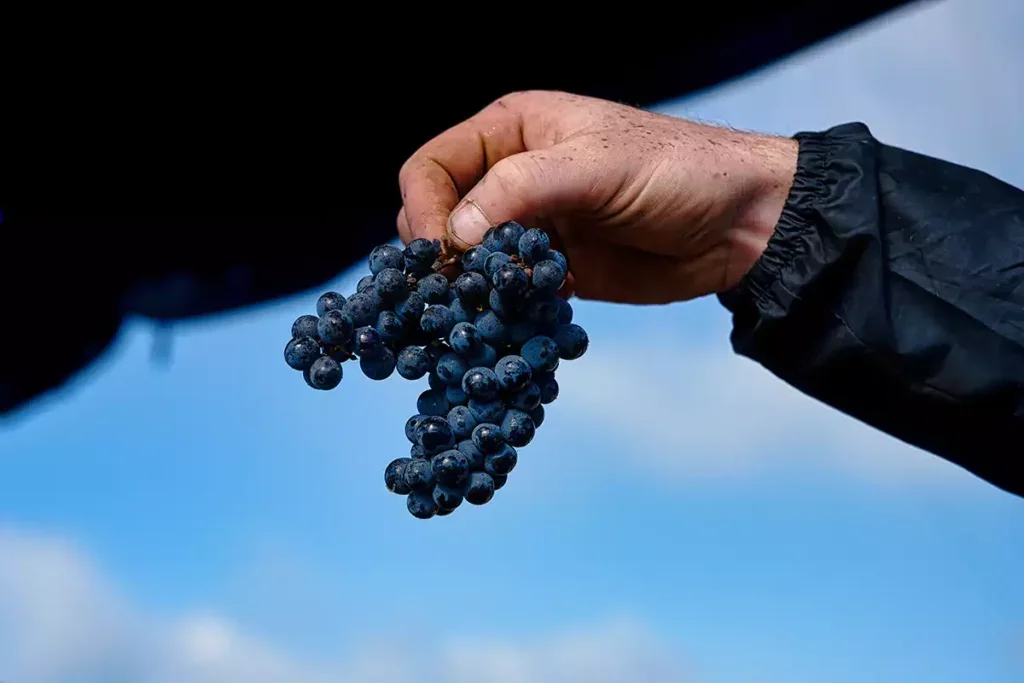
In the winery
The hard work was all done in the vineyards, often at great expense. In the winery, it was more a case of careful handling of a rare raw material and of not attempting to draw out too much. Some producers chaptalized; some submitted their musts to a saignée regime in order to achieve concentration. Some even resorted to reverse osmosis and the like to undermine the threat of dilution. Extraction methods were gentle, with a gentle press down generally preferred to the more frictional pressures of remontage (pumping over). Fermentation temperatures and maceration times were modified in accordance with the density of the fruit, and it is to be expected that the length of élevage will be similarly sensitive to the constraints imposed by the season. Those formerly considered somewhat maverick in their approach—such as Guillaume Pothier at Carmes Haut-Brion, with his regime of whole-bunch fermentation and passive extraction (“infusion” is the fashionable term now)—suddenly made a lot of sense. Carmes, indeed, is one of the top performers of the vintage once again.
Alcohol levels are low, which many see as a positive; although without the chaptalization, some of the Cabernets would have struggled to reach even 12%, something not seen since the ’90s. The approach to press wine, as ever, was varied, with both Latour and Montrose respectful of its textural potential, others rather less so… The technology today is such, one may argue, to manicure most perceived weaknesses, and no vintage is without some degree of merit. As long as terroir is not sacrificed, one may add, with a flourish of self-importance. We want our Pomerol to taste like Pomerol and our St-Estèphe to taste like St-Estèphe. They do exactly that in the best estates in 2024; Vieux Château Certan and Montrose come immediately to mind.
Style
Wines recalling the style of the late 1980s, but with more polish and better balance? Is this a truth, a truism, or a contradiction in terms? And have the wines, admittedly stylistically heterogeneous, lost their distinct Bordeaux identity? Overall no, and some may welcome the lower alcohol and a fruit profile that is nonetheless less indulgent and ripe.
Many have discussed the polarity between the “haves” and the “have nots”—a not entirely appropriate shorthand. The technological tools are expensive and certainly not available to all. Some wines are lean and stalky, acidic and lacking mid-palate integrity; sugar did not accumulate steadily, but the malic acid levels remained high. Ripeness was therefore essential, and demonstrably difficult to achieve, given the pluvious conditions. The aromatic precursors were, if anything, accentuated and can be included among the positives in 2024, which, by way of another positive feature, are generally brightly pigmented in color. An attractive iridescent purple rather than a Stygian opacity!
In terms of the fruit itself, there is a sense of forward accessibility, with both red- and black-fruit flavors, and some blue fruit, too; in short, a pleasing palette to reflect the homogeneity of the vintage. Pierre-Olivier Clouet at Cheval Blanc describes the wines as “long but not large [broad]”, suitably enigmatic yet perhaps capturing their personality; it would be foolish, in other words, to discount an attractive linear character in play, reminding us, perhaps, of 2001 or 2012, both of which are showing rather well now. The fresh blackberry and redcurrant flavors will be appealing in their youth, or relative youth, and there will be capacity for long aging evidenced in years such as 2009, 2015, or the increasingly impressive 2019. The accessibility is reflected in the modest alcohol levels, Figeac representative at 12.5%… modest by today’s standards at least. A classic, cultured vintage, one might say. The wines, as hinted above, are built on tension rather than raw power and will not want for adherents. The tannin levels are (relatively) low, but there is an attractive chalky persistence in the best examples. Such is their approachability that some have found another angle to question the purpose of the en primeur model, traditionally perceived as a “staging post” in a long period of development. Does one really need to buy wines like 2024 Bordeaux 2024 in this manner? Relatively early drinking vintages such as this may well be better off sold in bottle, with the final definitive blend secure and without the shadow of long aging. Perhaps en primeur, at the very least, should not take place every single year… a debate for another time, maybe.
In terms of location, there is a marginal preference for the Right Bank wines, with Merlot spared the indignities of the late rains and therefore given a little more time to achieve physiological ripeness. On the Left Bank, those who waited generally performed best, but those who waited too long were stymied by the darkening skies.
2024 Bordeaux en primeur: The markets
The backdrop to the 2024 Bordeaux en primeur campaign could scarcely be less auspicious. The canvas is darker than dark, without even much by way of chiaroscuro to lighten the mood. Global wine consumption (214 million hl in 2024) is the lowest since 1961, with France, in particular, significantly under par; its consumption of 24 million hl still makes up more than 10% of the total but is in fact 50% down on the volumes of 50 years ago. The decline is generational, structural, maybe inevitable… This is before one factors in the geopolitical inconveniences engendered by the fractured, fragile Asian market and the insecure and therefore very wary American market, not to mention significant disruption, not least to global energy markets, brought about by long-term conflicts and war. Even the usually reliable London wine merchants are paralyzed by overstocks and post-Brexit bureaucratic drag. All, in short, is not well, and even supply-side measures do little to conceal an absence of demand.
Bordeaux, it is said, is usually the first to dive into a crisis and almost always the first to pull out of it. At the moment, however, there is little sign of the redemptive side of this equation. Properties, especially in a weak (Atlantic) low-yielding vintage, have high unit costs and (the grandest properties notwithstanding) relatively modest margins, hungry for cash flow, which can soon be eroded by any need or perceived need to lower prices. A spiral of self-fulfilling decline is in no-one’s interest. Yet time and time again (in 2008, 2019, 2023, and now 2024) there has had to be a market recalibration in order to attempt to counter negative signals. Neither the economics nor the politics of realignment have, in this instance, proved to be immutable, leading, inevitably, to the conclusion that the business model itself must be flawed. How could it not be, a cynic might opine, when it has been so self-evidently favoring the supplier over the customer. Such a model is bound to fall apart when supply (however manicured) starts to exceed demand and when, as a result, prices cannot fail to slip. All very prosaic, all very predictably cyclical, one may think. The South Sea Bubble without the fizz.
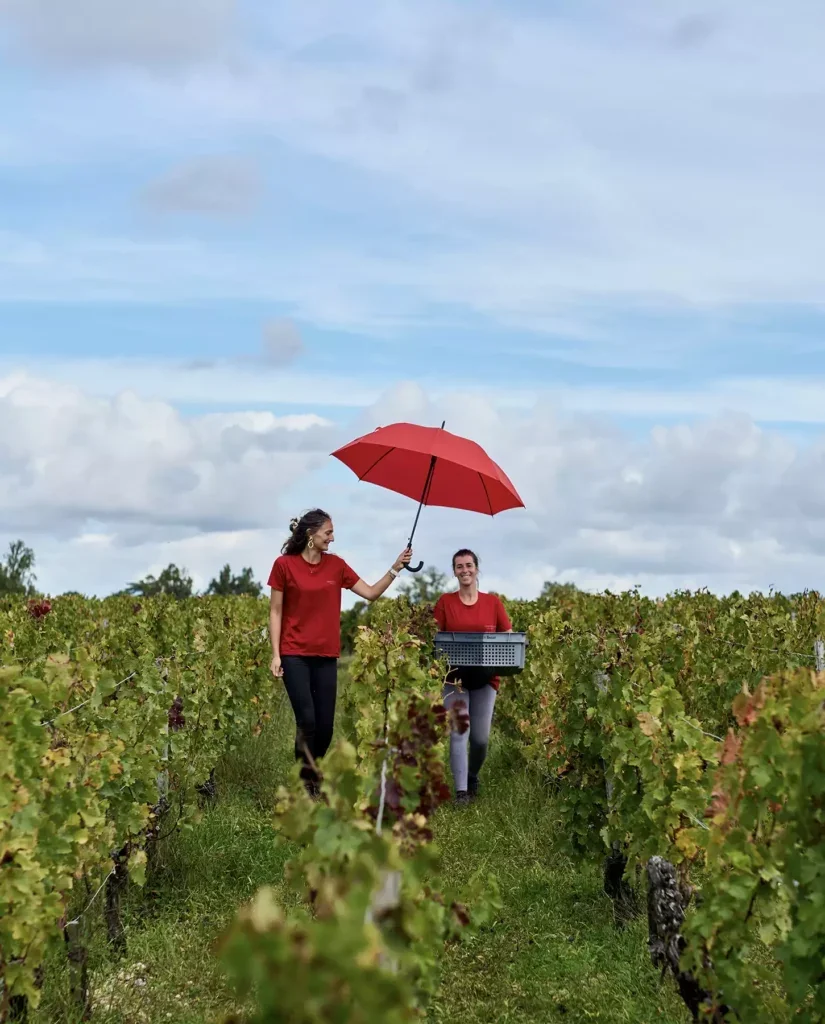
The average en primeur price fell by 18% from 2022 to 2023, admittedly partially reflecting the sheer quality of the ’22 vintage. The 2024 vintage is not to be a tale of high scores or demonstrable excellence; and it is faced with an increasingly skeptical and price-sensitive consumer. To say that the business model is creaking would be an understatement; it needs flying buttresses and, more prosaically, scaffolding, to keep it in place; but will such measures irrevocably undermine the aesthetic?
Bordeaux has the dubious honor of being a bell-weather, for better or for worse. In 2025, it is still, unfortunately, in a dip, and it looks as if only a sensible, or even radical, commercial realignment will stop the rot (if you will pardon the unfortunate pun). Costs have been increasing significantly of late, and selling below cost is unwise; the parameters are clear therefore. There should be no culture of loss leading, which is ultimately futile. The Bordelais will have to decide whether their en primeur business model, with its attractive cash-flow and marketing backdrop, is still feasible, and, if not, will have to revert to a more traditional sales mechanic. Selling an incomplete product is, after all, a somewhat unsatisfactory pitch. We would have loved it if Mahler and Schubert had been able to complete their final symphonies…
Bordeaux understands the nature of economic cycles, just as it understands the laws of nature’s unpredictability. It is used to adapting. The en primeur market, indeed, is relatively modern, a response to a significant upturn in the cycle. While not suggesting that it is or was irrevocably opportunistic, one can affirm that there is no permanence written into its lore. The relentless uprooting of the vines (130,000ha [321,200 acres] will be reduced to 80,000ha [197,700 acres] before long) continues apace, yet has little impact on the primeur market which, it is important to remember, concerns only the 70 or so properties at the very top of this vast pyramid. Pricing pressure, however, is evidenced at both the top and the bottom of this edifice, with very little by way of a “secure” middle ground. At the bottom there is no money to invest to meet the current climate challenges, with the additional anxiety of other regions and countries that are benefiting where Bordeaux is challenged. At the top, many properties have built extravagant cost bases to support a pricing regime from the top of a bull market, one that no longer exists. The support of the allegedly infallible selling construct (courtiers, négociants, and the Place de Bordeaux) can appear flabby and indulgent when times are hard. And the end consumer, in ironic recognition of the persuasive selling power of past years, is now sitting on a lot of stock, much of which is approaching maturity. There are certainly no easy solutions here.
So, how have the châteaux reacted to this dilemma, and, equally important, how have the markets responded? Early indications point to an awareness of the high stakes, at the very least. A modicum of progress, underlined by a more coherent dialogue between the properties, the négociants, and the merchants, appears to be taking hold. It is less clear, however, if this consensus will translate into hard sales.
The campaign, when one considers pricing, may be viewed in terms of meeting—or not—a set of increasingly demanding criteria. Have the prices come down since 2023? Yes, almost invariably. Are the prices the cheapest for a number of years? Again, the answer is looking like a yes. Most important, not least psychologically, is the wine the cheapest vintage currently available in the market? Early releases point to several affirmative answers here, too. The market is being pushed onward, but downward. Cheval Blanc came out at €276 (ex-négociant) per bottle, which is 30% cheaper than its 2023 and the cheapest release since 2015, and which, crucially, makes it the second-cheapest on the market, after the poor 2021 vintage. Add to this the conspiracy between a low-yielding vintage and a decision to both produce and release less than normal (55% in the case of production), and one lands upon a template that may, just may, ensure that the project does not fall completely flat. It is hardly a template for huge profitability, however.
Early observations, indeed, point to steady if not spectacular sales of wines from châteaux that follow the stricter of the models rehearsed above, Lafite (released at €288) and Mouton being other relatively successful examples. Ditto Angelus, Branaire-Ducru, and the highly regarded Montrose and Les Carmes Haut-Brion. Properties that did not make an effort to undercut the market look set to fare significantly less well; Batailley, Haut-Batailley, and Pontet-Canet being examples, the latter especially interesting, as it was scored highly by The Wine Advocate. The realpolitik of cold pricing seems set, in this somewhat challenged vintage, to bear more significance than the scores of even the most respected critics. If one speculates that it was Parker scores for the 1982 vintage that launched en primeur in the first place, maybe today, the diminished power of the critics and the lower interest in their scores (diluted by the fact that there are now so many casting judgment!) underlines the self-evident fragility of selling, unseen as it were, an unfinished product. Either way, the rhetoric of customer allocation—“You can only have this in a good vintage if you also buy that lesser wine and also buy it in a poor vintage”—appears anachronistic; a little vulgar even, one may dare to presume.
The 2024s are heterogenous by nature, even the best being physically svelte, upstanding, and relatively lean. They are articulate, often thanks to the best efforts of modern science, and, some may say, far better than they ought to be, given the relentless humid conditions. Be that as it may, most do not feel “made” and generally capture the sinewy tension beloved of all who appreciate fine claret. Many, indeed, laud the lower alcohol levels, more gravelly tannins, and natural pH levels that are significantly lower than those of warm years such as 2018 and 2022. Medium-term wines, then, and wines that could sell reasonably well at lower release prices. The “success” of the vintage is far from certain toward the end of May (at the time of going to press), and its reception appears to have been lukewarm at best, despite the lower prices. The ability of the châteaux to adapt to this new norm remains to be seen; many have stretched their cost bases too far to be able to accommodate significantly lower release prices. The bankruptcy courts may be kept busy… Across the region, any future red umbrellas may start to look a little mournful, and more singing in the rain harder to sustain.

